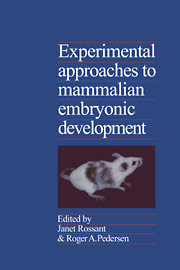Book contents
- Frontmatter
- Contents
- Preface
- Contributors
- Cellular aspects
- Molecular and biochemical aspects
- 6 Regulation of gene expression during mammalian spermatogenesis
- 7 Molecular aspects of mammalian oocyte growth and maturation
- 8 Utilization of genetic information in the preimplantation mouse embryo
- 9 Metabolic aspects of the physiology of the preimplantation embryo
- 10 Role of cell surface molecules in early mammalian development
- 11 Cell-lineage-specific gene expression in development
- 12 X-chromosome regulation in oogenesis and early mammalian development
- Toward a genetic understanding of development
- Index
7 - Molecular aspects of mammalian oocyte growth and maturation
from Molecular and biochemical aspects
Published online by Cambridge University Press: 31 March 2010
- Frontmatter
- Contents
- Preface
- Contributors
- Cellular aspects
- Molecular and biochemical aspects
- 6 Regulation of gene expression during mammalian spermatogenesis
- 7 Molecular aspects of mammalian oocyte growth and maturation
- 8 Utilization of genetic information in the preimplantation mouse embryo
- 9 Metabolic aspects of the physiology of the preimplantation embryo
- 10 Role of cell surface molecules in early mammalian development
- 11 Cell-lineage-specific gene expression in development
- 12 X-chromosome regulation in oogenesis and early mammalian development
- Toward a genetic understanding of development
- Index
Summary
Introduction
The process of oogenesis generates the egg whose central role in biology is exemplified by the statement “Omne vivum ex ovo”–“All living things come from eggs,” which is attributed to William Harvey. In the mouse, oogenesis begins with the formation of the primordial germ cells in the 8-day-old embryo. These cells are the sole source of germ cells and are readily identifiable by a variety of histochemical and ultrastructural criteria. By day 14 post fertilization, some of the primordial germ cells, which are initially found in the region of the allantois, have migrated to and colonized the genital ridge of the presumptive gonad, which is situated near the kidney. The oogonia then undergo a last round of DNA synthesis and are transformed into oocytes that enter meiotic prophase by day 14 post fertilization. This prophase is characterized by a series of changes in chromosome morphology. By day 5 post partum the primary oocytes have entered the dictyate stage in which the chromosomes are highly diffuse and presumably transcriptionally active. The ovary is now populated with thousands of small oocytes about 12–20 μm in diameter that are arrested in the dictyate stage of the first meiotic prophase. They remain at this stage until just prior to ovulation, a period extending from several weeks to the length of the reproductive life span of the animal; this feature is common to all mammalian species.
Following a period of oocyte growth (oocyte diameter increases to about 80 μm during a period of about 14 days), ovulation and resumption of meiosis are initiated by a hormonal stimulus.
- Type
- Chapter
- Information
- Experimental Approaches to Mammalian Embryonic Development , pp. 195 - 238Publisher: Cambridge University PressPrint publication year: 1987
- 7
- Cited by



